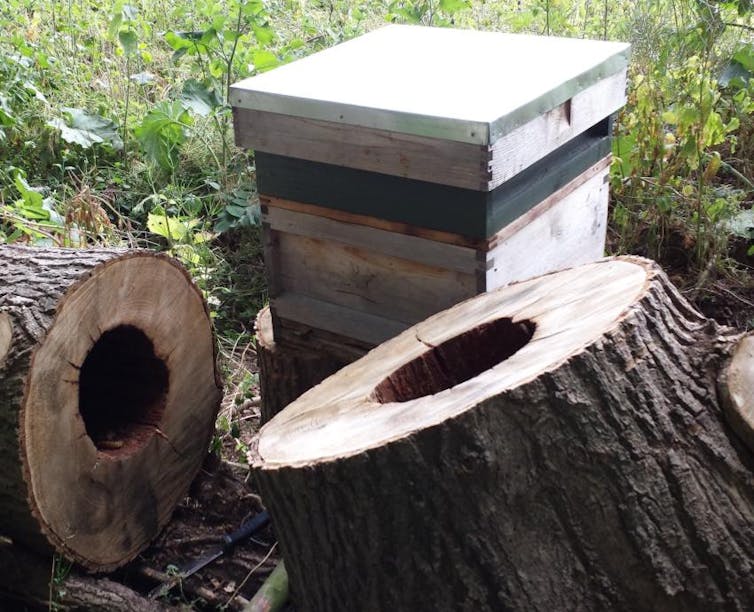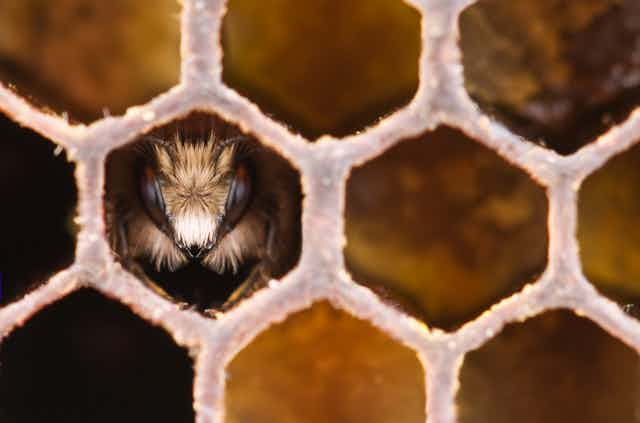Honeybees in man-made hives may have been suffering the cold unnecessarily for over a century because commercial hive designs are based on erroneous science, my new research shows.
For 119 years, a belief that the way honeybees cluster together gives them a kind of evolutionary insulation has been fundamental for beekeeping practice, hive design and honeybee study. More recently, California beekeepers have even been putting bee colonies into cold storage during summer because they think it is good for brood health.
But my study shows that clustering is a distress behaviour, rather than a benign reaction to falling temperatures. Deliberately inducing clustering by practice or poor hive design may be considered poor welfare or even cruelty, in light of these findings.
Honeybee (Apis mellifera) colonies don’t hibernate. In the wild they overwinter in tree cavities that keep at least some of their numbers above 18°C in a wide range of climates, including -40°C winters. But popular understanding of their overwintering behaviour is dominated by observation of their behaviour in thin (19mm) wooden hives. These man-made hives have very different thermal properties compared with their natural habitat of thick-walled (150mm) tree hollows.

Getting through winter
On cold days in these thin-walled hives, colonies form dense disks of bees, called a cluster, between the honeycombs. The centre of these disks (the core) is less dense and warmer (up to 18°C). This is where the honeybees produce most of the heat by eating and metabolising the sugar from honey. The cooler outer layers (mantle) produce very little heat as the bees’ body temperatures are too low. If the temperature falls much below 10°C, the bees there will die.
Since 1914, beekeeping texts and academic papers have said the mantle “insulates” the inner core of the hive. This meant beekeepers saw clustering as natural or even necessary. This belief was used in the 1930s to justify keeping honey bees in thin-walled hives even in -30°C climates. This led, in the late 1960s in Canada, to a practice of keeping honeybees in cold storage (4°C) to keep them clustered over the winter.
In the 2020s, keepers are refrigerating honeybees in summer to facilitate the chemical treatment of parasites. This is happening across the US – for example in Idaho, Washington and Southern California. Outside of a cold winter, if beekeepers want to treat mite infestations, they normally have to locate and cage the queen. But cold storage means beekeepers can skip this labour-intensive step, making their commercial pollination services more profitable.
Struggling for warmth
However, my study found cluster mantles act more like a heatsink, decreasing insulation. Clustering is not a wrapping of a thick blanket to keep warm, but more like a desperate struggle to crowd closer to the “fire” or die. The only upside is that the mantle helps keep the bees near the outside alive.
As the temperature outside the hive falls, bees around the mantle go into hypothermic shutdown and stop producing heat. The mantle compresses as the bees try to stay above 10°C.
The mantle bees getting closer together increases the thermal conductivity between them and decreases the insulation. Heat will always try to move from a warmer region to a colder one. The rate of heat flow from the core bees to the mantle bees increases, keeping those bees on the outside of the mantle at 10°C (hopefully).
Think of a down jacket – it’s the air gap between the feathers that help keeps the wearer warm. Honeybee clusters are similar to the action of compressing a down jacket, whereby the thermal conductivity eventually increases to that of a dense solid of feathers, more like a leather jacket.
In contrast, when penguins are huddling in the Antarctic winter, they all keep their body core hot at similar temperatures, and therefore there is little or no heat transfer between the penguins. Unlike the bees in the mantle, there aren’t any penguins in a hypothermic shutdown.
Academics and beekeepers have overlooked the part played by the invisible air gap between the hive and the cluster. The thin wooden walls of commercial hives act as little more than a boundary between the air gap and the outside world. This means that for hive walls to be effective, they have to be substantially insulating, such as 30mm of polystyrene.
This misunderstanding of the complex interaction between the colony enclosure, thermofluids (heat, radiation, water vapour, air) and honeybee behaviour and physiology are a result of people not recognising the hive as the extended phenotype of the honey bee. Other examples of extended phenotype include a spider’s web and a beaver’s dam.
There are almost no ethics standards for insects. But there is growing evidence that insects feel pain. A 2022 study found that bumblebees react to potentially harmful stimuli in a way that is similar to pain responses in humans. We urgently need to change beekeeping practice to reduce the frequency and duration of clustering.

Don’t have time to read about climate change as much as you’d like?
Get a weekly roundup in your inbox instead. Every Wednesday, The Conversation’s environment editor writes Imagine, a short email that goes a little deeper into just one climate issue. Join the 20,000+ readers who’ve subscribed so far.


